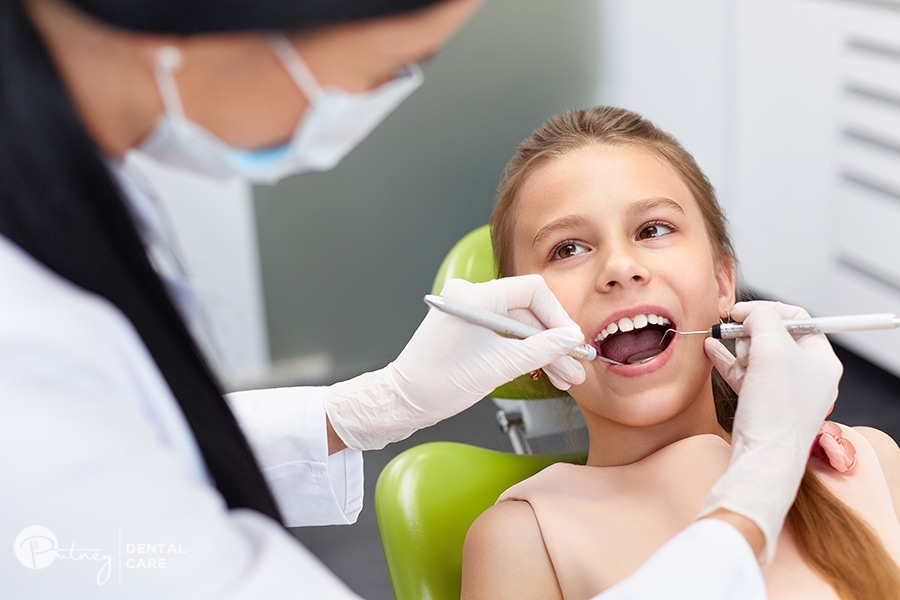
Pulpotomy
What is a Pulpotomy?
A pulpotomy is a dental procedure in which the pulp in the crown of a tooth is removed in order to save the tooth from infection or decay. Pulp is found in both the roots and the crown of a tooth and is the soft tissue that is comprised of nerves and blood vessels.
A pulpotomy is most often performed on baby teeth in children, but can be successful for adult teeth as well. Your dentist may recommend a pulpotomy if the pulp tissue in your tooth has been exposed to decay or infection or if you have a severe cavity.
Pulpitis

A pulpotomy may be recommended for your child if they begin showing signs of pulpitis, which is the inflammation of the pulp. Pain and sensitivity to hot, cold or very sweet foods is usually the first symptom of pulpitis. Pulpitis is usually caused by tooth decay (dental caries) that has been left untreated, and is often a result of poor dental hygiene.
A pulpotomy is also often necessary if there is tooth decay present that is very close to the pulp in the crown and removing the tooth decay will expose the pulp.
Another less common reason for having a pulpotomy is if the child has sustained severe physical trauma to the tooth.
It’s important to try to manage tooth decay early before it can develop into something serious, so if you notice any yellow stains on your child’s teeth you should arrange for a dental check up.
Pulpotomy in Children
Pulpotomies are often recommended for children because their baby teeth (or primary teeth) need to remain intact to provide the appropriate spacing for their permanent teeth to come through. Caring for your child’s primary teeth is important to avoid any further dental problems later on. Primary teeth have an immature root formation, so a pulpotomy is more likely to have the desired result.
A pulpotomy can be performed on an adult, but a root canal is usually recommended instead.
Pulpotomy vs Pulpectomy
A pulpotomy is performed to remove some of the pulp in a tooth, and only in the crown (coronal pulp). When a pulpotomy is performed, the roots of the teeth stay intact and the tooth is still able to grow.
A pulpectomy removes all of the pulp from the tooth, including the pulp in the roots. Pulpectomies are often performed on teeth with dead or infected pulp tissue or an abscess. The purpose of a pulpectomy is to completely remove pulp from both the crown and the roots of the tooth, and then either fill it back up with a different material or place a stainless steel crown on the tooth. A pulpectomy is often required if the infection has extended into the roots.
A pulpectomy is often performed on a severely infected baby tooth, but can also be performed on an adult tooth as the first step in a root canal.
Risk of Not Operating
Leaving an infected tooth untreated can cause a number of other complications, such as pain, swelling and the death of soft tissues. Pulpitis may not cause any pain at first, but if a pulpotomy is needed and not performed, the tooth will not get better on its own and may eventually need to be removed. The infection could also spread to the jaw and cause an abscess.
It’s important for children to keep all their baby teeth so that the adult teeth can erupt in the appropriate positions. So if the infected tooth does need to be removed, it could result in eruption problems later on.

Preparing Your Child For a Pulpotomy
Any surgical or dental procedure can be anxiety inducing for a child, so make sure your child knows that the treatment itself will not hurt and that it’ll take away any pain or discomfort that they’ve been experiencing. The procedure will take place in the children’s dentistry.
You should tell your child what will happen so that they know what to expect. The procedure itself will usually take 30-45 minutes. Your child can wear comfortable clothing and may take a comfort item (such as a soft toy) with them if it’ll help to put them at ease.
Pulpotomy Steps
Before the procedure begins, the child will be able to get comfortable in the dental chair and they might be able to watch something if there is a TV in the room.
1. Administering Local Anaesthetic
Topical anaesthetic will be applied over the gums in the form of a gel, before local anaesthetic is injected into the gums. The topical anaesthetic is used to make this injection more comfortable. In some cases, the child may need to be sedated.
2. Tooth Decay Removal
A rubber dam will be placed into the child’s mouth to make it easier to work on the tooth in question by limiting saliva and reducing the chance of the child accidentally swallowing something. The dentist will then remove any tooth decay on or around the tooth.
3. Open Pulp Chamber
The dentist will drill through the enamel to open the pulp chamber. At this point the dentist can only continue with the procedure if the pulp is healthy. If the pulp is not bleeding or there’s no pulp then a pulpectomy or tooth extraction may need to be performed instead.
4. Pulp Tissue Removal
The inflamed pulp will then be removed and cotton swabs will be used to stop the bleeding.
5. Dental Crown Placement
The remaining pulp in the roots will then be treated and covered to protect it, and the pulp chamber will be sealed and restored. A filling or a stainless steel crown may be used for this.
Pulpotomy Risks & Complications
This procedure has a high success rate. If the tooth continues to cause pain after the procedure you should return to the dentist for a possible extraction. Some common complications that occur as a result of this procedure include:
- Mild, temporary pain and inflammation
- Discolouration of teeth
- The tooth may fracture (the use of stainless steel crowns or strong fillings such as zinc oxide eugenol helps to prevent this)
- Possible infection
There is also the risk that the pulp inside the tooth is either dead or more inflamed than expected, and the tooth may need to be extracted instead.
Local Anaesthetic with Children
Children may need to be supervised until the anaesthetic has worn off completely, because they may be tempted to bite or rub the inside of their cheeks and cause bleeding or damage.
Post Pulpotomy Care
Children will be monitored for 30-60 minutes after the procedure to make sure there are no complications. Vomiting, nausea, drowsiness and slight bleeding are common following the treatment.
Your child may experience some mild pain or swelling for a few days after the procedure and over the counter medication should be able to help with this. Your dentist will provide instructions about the kind of foods that they should eat while recovering, which will most likely be soft foods like scrambled eggs.
Your child will not be able to eat candy or sticky foods for a while, and they should also try not to eat on the side of their mouth where the procedure was performed.
FAQs
What is Pulpitis?
Pulpitis is the inflammation of your dental pulp, usually as a result of untreated cavities or decay.
What Does Pulpitis Feel Like?
The most obvious symptom of Pulpitis is pain or sensitivity to hot or cold foods.
What’s the Difference Between a Pulpotomy and Pulpectomy?
A pulpotomy is performed to remove only the pulp in the crown of the tooth, in order to preserve the health and structure of a primary tooth. A pulpectomy is performed when the pulp is either dead or too inflamed to be restored, so all of the pulp is removed from both the crown and the roots.
Is Pulpotomy the Same Procedure as Root Canal Treatment?
A pulpotomy has some similarities to a root canal treatment, but they are different procedures. A pulpotomy removes only some of the pulp from the tooth, while a root canal removes the pulp completely before the tooth is filled and sealed. Root canals are difficult to perform on children, so are usually only performed on permanent teeth.
Children's Dentist Near Me
Address
A. Suite 5, 227 Morrison Rd, Putney, NSW 2112
(Next Door To Royal Rehab)
Reserved Parking Available At Rear.
Opening Hours
Monday – 8:30 am – 5:30 pm
Tuesday – 8:30 am – 5:30 pm
Wednesday – 8:30 am – 5:30 pm
Thursday – 8:30 am – 5:30 pm
Friday – 8:30 am – 5:30 pm
Saturday – 8:00 am – 1:00 pm
Emergency Appointments Available
Call us today on (02) 9808 2588 or book an appointment online.
Book Online